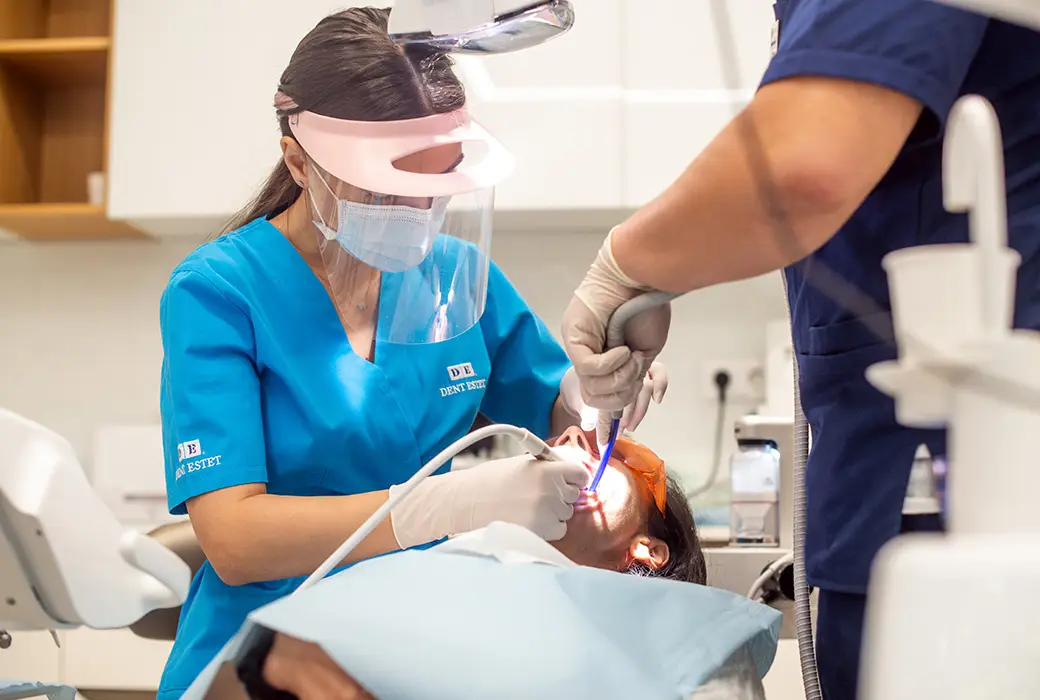
What is dental pulpitis?
Inside each tooth, there is an area called the dental pulp. This contains, in addition to the nerve, blood vessels, and connective tissue. Dental pulpitis is a condition caused by the inflammation of this dental pulp. It can occur in one or more teeth and is caused by bacteria that invade the tooth pulp, leading to its inflammation (swelling).
There are two forms of dental pulpitis: reversible and irreversible. Reversible pulpitis refers to cases where the inflammation is mild, and the tooth pulp remains healthy enough to be saved. Irreversible pulpitis occurs when the inflammation and other symptoms, such as pain, are severe, and the pulp cannot be saved.
Irreversible dental pulpitis, due to continuous bacterial contamination, can lead to dental infections and periapical lesions, as bacteria migrate along the tooth root and pass the root tip, multiplying around it. This can result in actual pockets of pus, called periapical abscesses. If left untreated, these lesions can invade neighboring structures: the maxillary sinus, mandibular canal, nasal fossae, etc.
Another way to categorize the condition is by classifying it as acute dental pulpitis and chronic dental pulpitis. The difference between acute and chronic pulpitis is the intensity and duration of the pain. Acute pulpitis pain comes on suddenly and can be quite intense, while chronic pulpitis is characterized by milder but long-lasting pain.
Dental pulpitis – symptoms
Both types of pulpitis cause pain, although the pain caused by reversible pulpitis may be milder and occurs only during chewing.
The pain associated with irreversible pulpitis can be more severe and occurs throughout the day and night.
Other symptoms of both forms of pulpitis include:
- Inflammation;
- Sensitivity to hot and cold foods;
- Sensitivity to very sweet foods.
Irreversible pulpitis may include additional infection symptoms such as:
- Fever;
- Swollen lymph nodes;
- Bad breath;
- Unpleasant taste in the mouth.
Here are the symptoms of the types of dental pulpitis:
REVERSIBLE PULPITIS
Symptom:
- General pain - moderately intense;
- Dental sensitivity - short and quick;
- Inflammation around the tooth - rare;
- Fever - unlikely;
- Bad breath - no;
- Increased pain when lying down - no.
IRREVERSIBLE PULPITIS
Symptom:
- General pain - throbbing;
- Dental sensitivity - more than 30 seconds;
- Inflammation around the tooth - present;
- Fever - present;
- Bad breath - present;
- Increased pain when lying down - present.
CHRONIC PULPITIS
Symptom:
- General pain - low intensity;
- Dental sensitivity - short and quick;
- Inflammation around the tooth - rare;
- Fever - unlikely;
- Bad breath - possible;
- Increased pain when lying down - no.
ACUTE PULPITIS
Symptom:
- General pain - throbbing;
- Dental sensitivity - very painful;
- Inflammation around the tooth - present;
- Fever - present;
- Bad breath - possible;
- Increased pain when lying down - present.
If you experience any of these symptoms, you should visit a dentist as soon as possible. Symptoms of irreversible pulpitis include extreme pain, and sometimes even painkillers will not help relieve the pain of pulpitis. If the pain becomes unbearable, you should seek an emergency consultation with a dentist.
Dental pulpitis - causes
In a healthy tooth, the layers of enamel and dentin protect the pulp from dental infections. Pulpitis occurs when these protective layers are compromised, allowing bacteria to enter the pulp, causing swelling. The pulp is trapped within the tooth walls, so the swelling causes pressure and pain, as well as infection.
The enamel and dentin layers can be damaged by several conditions, including:
- dental caries that cause tooth erosion;
- injuries, such as an impact to the tooth;
- having a fractured tooth that exposes the pulp;
- repetitive trauma caused by dental issues such as jaw misalignment or bruxism.
Dental pulpitis - risk factors
In general, factors that increase the risk of dental cavities, such as living in an area without fluoridated water or having certain medical conditions like diabetes, can also increase the risk of dental pulpitis.
Children and older adults may also be at increased risk, but this is largely determined by the quality of dental care and oral hygiene habits.
Lifestyle factors can typically increase the risk of dental pulpitis:
- Poor oral hygiene habits at home by not brushing teeth after every meal;
- Not having regular check-ups with the dentist;
- A diet high in sugar or consuming foods and drinks that promote tooth decay, such as refined carbohydrates;
- Professions or hobbies that increase the risk of impact to the mouth, such as boxing or hockey;
- Chronic bruxism.
Dental pulpitis - diagnosis
Pulpitis is usually diagnosed by a dentist. The dentist will examine your teeth and request a dental X-ray to accurately determine the extent of the cavities and inflammation. A sensitivity test may also be conducted to see if you feel pain or discomfort when the tooth comes into contact with heat, cold, or sweet stimuli. The extent and duration of your reaction to these stimuli can help the dentist decide whether the entire pulp or just a part of it has been affected.

An additional test where the dentist uses a light, blunt instrument to gently tap on the affected tooth helps determine the extent of the inflammation.
The dentist can also analyze how much of the tooth pulp is damaged using an electric pulp tester. This instrument delivers a tiny electric charge to the tooth pulp. If you can feel this charge, your tooth pulp is considered viable, and the pulpitis is most likely reversible.
Dental pulpitis - treatment
Treatment methods vary depending on the type of dental pulpitis the patient is suffering from.
In the case of reversible pulpitis, treating the cause of the inflammation should resolve the symptoms. For example, if there is a cavity, removing the decayed area and restoring it should alleviate and eventually eliminate the pain.
If the patient has irreversible pulpitis, the dentist will recommend consulting an endodontic specialist. If possible, the tooth may be saved through a procedure called pulpectomy. This is the first stage of a root canal treatment. During a pulpectomy, the pulp is removed, but the rest of the tooth is left intact. After the pulp is removed, the empty space inside the tooth is disinfected, filled, and sealed.
In some cases, the entire tooth may need to be removed through extraction. Tooth extraction is recommended if the tooth is non-vital and cannot be saved.
After a pulpectomy or tooth extraction, notify the surgeon if you experience any of the following symptoms:
- severe pain or pain that worsens;
- swelling inside or outside the mouth;
- sensation of pressure;
- recurrence or continuation of the initial symptoms.
Management of dental pain
Pain management, both before and after treatment, is usually done with anti-inflammatory medications. These provide relief from pain and inflammation. They should be taken only on the recommendation of the dentist, in the appropriate dose for each patient. In the case of a root canal treatment or tooth extraction, the dental surgeon may prescribe stronger pain medications.
Dental pulpitis - prevention methods
Dental pulpitis can often be avoided by maintaining good oral hygiene and visiting the dentist regularly. Reducing or eliminating sugary foods and drinks, such as carbonated beverages, cakes, or candies, can also be helpful. If you suffer from bruxism, a dental guard can help protect your teeth.


